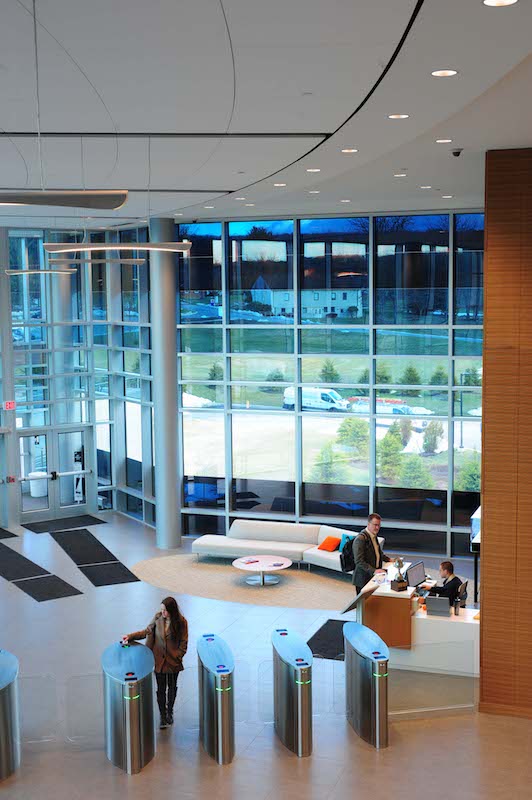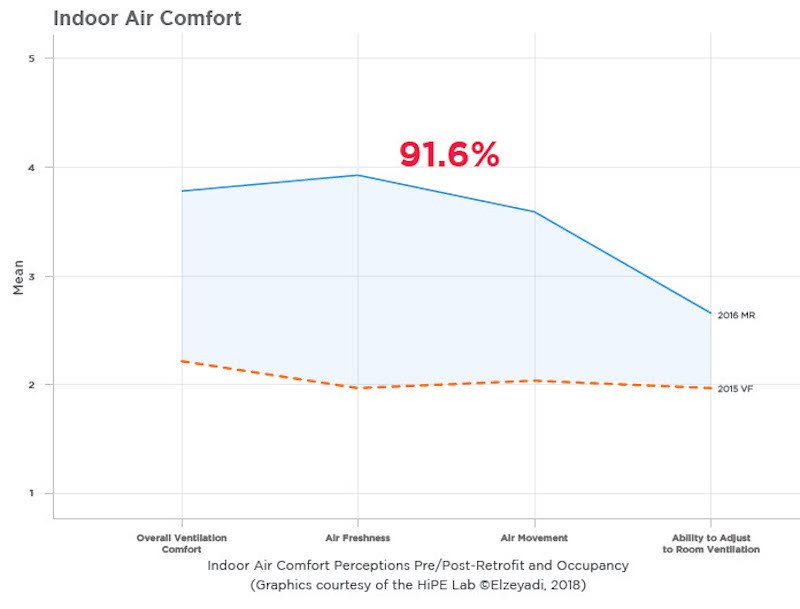Saint Gobain, the giant building materials supplier, has released the results of a three-year-long study that compared occupant comfort for the 800 employees at its old headquarters in Valley Forge, Pa., with the comfort levels for those same employees after they moved into the company’s new 277,000-sf North American headquarters in Malvern, Pa., which opened in October 2015.
That new LEED Platinum-certified building—an adaptive reuse of an office building that entailed 85% renovation and 15% new construction—is a “living laboratory” for Saint Gobain’s current and newly created products. The headquarters also showcases more than 60 innovative technologies.
The four-phase study, buttressed by a 76-question employee survey, found significant improvements in employees’ perceptions about indoor air quality, visual comfort, and acoustic comfort as a result of Saint Gobain’s “multi-comfort design approach” that combines sustainability, aesthetics, and comfort to improve occupant well-being. However, improving thermal comfort proved to be a harder nut to crack.
The study’s results are informing Saint Gobain’s new 30-story worldwide headquarters under construction in Paris.
Saint Gobain “wants to be the leader in habitat” by aggressively promoting its multi-comfort approach, says Stanley Gatland II, Manager of Building Sciences and Comfort for the company’s CertainTeed division. “We want to make occupant outcomes part of the conversation” with customers, adds Lucas Hamilton, CertainTeed’s Manager of Building Science Applications.
Four-step process
To evaluate the impact and efficacy of multi-comfort design elements in the new headquarters, Saint-Gobain partnered with a group of experts led by Dr. Ihab Elzeyadi, Director of the University of Oregon’s High Performance Environments (HiPE) Lab, to conduct an extensive four-phase comparative analysis of Indoor Environmental Quality (IEQ).
In the first phase of the study, a research team inspected the existing unoccupied Malvern facility prior to its adaptive renovation and reuse. In the second phase, the team examined the former Saint-Gobain headquarters in Valley Forge, to establish a benchmark for the performance of the new headquarters. In phase three, the team analyzed the new headquarters following envelope upgrades and interior design retrofits, but prior to occupancy. Finally, the fourth phase of the study assessed the newly completed Malvern headquarters post-occupancy.
Employees were questioned while they still worked at Valley Forge, as well in the fall of 2016 and 2017, after they had settled into the new headquarters. The questionnaires touched on 30 issues pertaining to workspace characteristics, indoor environment quality, comfort of ambient quality, health and well being, and productivity.

Electrochromic SageGlass on the building's southern and western facades contributed to employees' improved visual comfort. Image: Saint Gobain
The visual comfort parameter focused on daylighting and, more specifically, the relative impact of installing Saint Gobain’s SageGlass on the building’s western and southern façades. That electrochromic glazing provides three levels of tinting that are selected automatically in response to system programming and the changing light conditions throughout the day. These are detected by sensors on the roof of the building. The brightness of interior LED luminaires is similarly controlled according to incoming daylight.
In the old headquarters, less than half of the employees had access to daylight; in the new building, 92%. Only 4% of individuals now lack access to outside windows at their workspaces, compared to 23% at the former headquarters.
Unsurprisingly, employees reported a 56.4% overall improvement in visual comfort in the new headquarters, including gains of 30% to 60% in each of the following categories: overall lighting comfort, amount of light for working, glare from electric lights, ability to adjust to electric light, amount of daylight, glare from windows and the ability to adjust window shades.
To evaluate thermal comfort, Saint Gobain invested in significant upgrades to the new building’s core and envelope during renovation, including improved insulation, solar-reflective roofing, high-efficiency glazing, argon-gas-filled insulated glass, aluminum curtain wall systems and high-performance heating and cooling equipment.
The research team calculated thermal comfort conditions in accordance with ANSI/ASHRAE Standard 55-2013 and used electronic sensors over a long period of time to collect data on temperature, relative humidity, air velocity, globe temperature and air movement across various micro-climates in the Malvern facility.
Employees reported only a 4.8% improvement in thermal comfort in the new headquarters compared to the old. At key points during summer months, residents found themselves shifting from overly air-conditioned environments to hot, humid ones over a span of just a few hours.
Hamilton points out that the developer of the new headquarters (which wasn’t Saint Gobain) insisted on repurposing as much of the Malvern office structure as possible, including its mechanicals. Consequently, the HVAC system wasn’t always rightsized for a new headquarters with 116 collaborative spaces. Hamilton believes that thermal comfort results would be “a lot better” in projects that are completely new construction or have more extensive renovations.
“One lesson we learned was to spend more time reviewing whether to retain or replace existing building systems, especially when an extensive renovation will fundamentally change how a building will perform,” Saint Gobain stated in its report on the study.
Better results for acoustics and air quality
The study found much greater success in improving acoustic and indoor air quality. For acoustic comfort, the new headquarters was designed with sound-absorbing surfaces, high-performance interior partitions and exterior facades, isolating vibrating components in the HVAC system, and equipped with white noise machines to mask sound and manage speech intelligibility.
Saint Gobain also mapped the building’s sound absorption, sound levels, and workstation distraction distances to evaluate the effectiveness of its acoustic comfort tactics. It achieved a 42.2% improvement in employee perceptions.

Employees' perceptions of the new headquarters' indoor air quality were significantly higher than how they felt about their old workplace. Image: Saint Gobain
The new building’s air quality was monitored along seven discrete facets of design: outdoor air ventilation, particulate filtration, dehumidification, moisture flow management, air leakage control, Volatile Organic Compound (VOC) control, and contaminant capture.
The design included two wall covering products: one with the ability to trap and neutralize 70% of harmful aldehydes, and another designed with an antimicrobial coating that actively repels and kills fungus and black mold. Drywall tape had mold- and mildew-resistant properties. Backerboard was moisture and mold resistant. Wallboard and ceilings absorbed and converted formaldehyde a safe, inert compound.
The result: a 91.6% improvement in employee perceptions about indoor air quality. “A week after moving into the [Malvern] building, some employees thought we were pumping oxygen into the building,” recalls Hamilton.
Overall, employees reported that levels of visual, acoustical and indoor air quality comfort were 26.3% greater on average at the Malvern facility than at Valley Forge. Additionally, occupants’ satisfaction with indoor environmental quality (a measurement composed of employees’ ratings of temperature, lighting quality, acoustics, air quality, smell, ergonomics and space function) improved by 47.9% in the new space.
Does employee comfort translate to better productivity? Maybe. Saint Gobain compared the performance of its internal sales team in its last week in Valley Forge with its first week in Malvern. The team fielded the same number of calls in both weeks, but qualified leads jumped by 150%, and sales in the latter week were $5.6 million higher.
Related Stories
| Aug 11, 2010
Arup, SOM top BD+C's ranking of the country's largest mixed-use design firms
A ranking of the Top 75 Mixed-Use Design Firms based on Building Design+Construction's 2009 Giants 300 survey. For more Giants 300 rankings, visit http://www.BDCnetwork.com/Giants
| Aug 11, 2010
10% of world's skyscraper construction on hold
Emporis, the largest provider of global building data worldwide, reported that 8.7% of all skyscrapers listed as "under construction" in its database had been put on hold. Most of these projects have been halted in the second half of 2008. According to Emporis statistics, the United States had been hit the worst: at the beginning of 2008, "Met 3" in Miami was the only U.S. skyscraper listed as being "on hold". In the second half of the year, 19 projects followed suit.
| Aug 11, 2010
Structure Tone, Turner among the nation's busiest reconstruction contractors, according to BD+C's Giants 300 report
A ranking of the Top 75 Reconstruction Contractors based on Building Design+Construction's 2009 Giants 300 survey. For more Giants 300 rankings, visit http://www.BDCnetwork.com/Giants
| Aug 11, 2010
IFMA workplace study: Average space per employee up 40 sf since 2007, likely due to corporate layoffs
The International Facility Management Association has released “Operations and Maintenance Benchmarks, Research Report #32,” a study outlining the facility trends affecting workplaces throughout North America. Among the new report’s findings are that the average space per person has risen nearly 40 square feet since 2007, likely due to recent corporate layoffs.
| Aug 11, 2010
'Too cold' and 'too hot' most common complaints among office workers, says IFMA study
The International Facility Management Association has released “Temperature Wars: Savings vs. Comfort,” a new study that takes an in-depth look at the most common thermal complaints made by workers and the variety of ways facility professionals respond to them.For many years, IFMA has surveyed facility professionals to learn the top office complaints among employees.
| Aug 11, 2010
Best AEC Firms of 2011/12
Later this year, we will launch Best AEC Firms 2012. We’re looking for firms that create truly positive workplaces for their AEC professionals and support staff. Keep an eye on this page for entry information. +
| Aug 11, 2010
Manitoba Hydro Place, Tornado Tower among world's 'best tall buildings,' according to the Council on Tall Buildings and Urban Habitat
The Council on Tall Buildings and Urban Habitat last week announced the winners of its annual “Best Tall Building” awards for 2009, recognizing one outstanding tall building from each of four geographical regions: Americas, Asia & Australia, Europe, and Middle East & Africa. This year’s winners are: Manitoba Hydro Place, Winnipeg, Canada; Linked Hybrid, Beijing, China; The Broadgate Tower, London, UK; Tornado Tower, Doha, Qatar.
| Aug 11, 2010
AAMA leads development of BIM standard for fenestration products
The American Architectural Manufacturers Association’s newly formed BIM Task Group met during the AAMA National Fall Conference to discuss the need for an BIM standard for nonresidential fenestration products.






